Battle of Berlin
![]()
This article is about the 1945 Battle of Berlin. For the Royal Air Force bombing campaign known as the Battle of Berlin from November 1943 to March 1944, see Allied air raids on Berlin.
Battle for Berlin
Part of: World War II
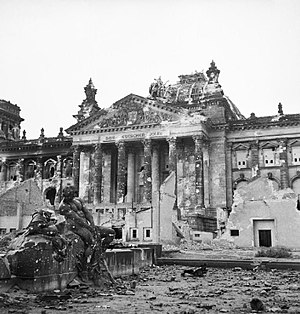
Ruin of the Reichstag after the battle (June 1945)
Significant military operations during the German-Soviet War
1941: Białystok-Minsk - Dubno-Luzk-Rivne - Smolensk - Uman - Kiev - Odessa - Leningrad Blockade - Vyazma-Bryansk - Kharkov - Rostov - Moscow - Tula1942
: Rzhev - Kharkov - Operation Blue - Operation Brunswick - Operation Edelweiss - Stalingrad - Operation Mars1943
: Voronezh-Kharkov - Operation Iskra - Northern Caucasus - Kharkov - Enterprise Citadel - Oryol - Donets-Mius - Donbass - Belgorod-Kharkov - Smolensk - Dnepr1944
: Dnepr-Carpathians - Leningrad-Novgorod - Crimea - Vyborg-Petrosavodsk - Operation Bagration - Lviv-Sandomierz - Yassy-Kishinev - Belgrade - Petsamo-Kirkenes - Baltic States - Carpathians - Hungary1945
: Courland - Vistula-Oder - East Prussia - West Carpathians - Lower Silesia - East Pomerania - Lake Balaton - Upper Silesia - Vienna - Oder - Berlin - Prague
The Battle of Berlin was the last major battle of the SecondWorld War in Europe. It lasted from April 16 to May 2, 1945, and resulted in the occupation of Berlin, the capital of the German Reich, by the Soviet Union's Red Army with the participation of some Polish units. The fighting was estimated to have resulted in over 170,000 soldiers killed and 500,000 wounded, as well as the deaths of tens of thousands of civilians.
After the liberation of the Wehrmacht-occupied territories of Europe, which had already largely taken place, the end of the battle, which was accompanied by the suicide of parts of the politically responsible governing stratum of the Nazi regime - in Berlin, the suicide of Adolf Hitler and Joseph Goebbels - meant complete military defeat for the German Reich.
Less than a week after the capture of Berlin, the unconditional surrender of the Wehrmacht came into effect on May 8, 1945, signed by Colonel General Alfred Jodl, who had been authorized to sign it by Hitler's successor as Reich President, Grand Admiral Karl Dönitz. This ended the Second World War in Europe after almost six years. Germany lost its state sovereignty. The victorious powers assumed sovereignty over the German Reich and divided it into four occupation zones.
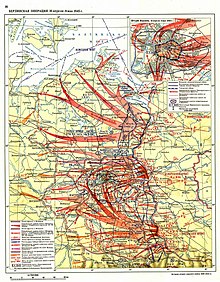
The Soviet Offensive against Berlin from April 16, 1945 onward
Previous story
In fact, the defeat of the German Reich in the war was certain even before the Battle of Berlin began. The dimensions of the campaigns led by the Wehrmacht against other countries were out of balance with the human and economic reserves of the Reich. With the duration of the war, which led to both planned attacks and unexpected military actions against other countries (cf. Balkan campaign, Fall of the Axis), German resources became increasingly scarce. At the same time, however, the territory to be administered and supplied became larger and larger. Thus, an economic defeat in the war could only have been prevented if the war had been as short as possible, but this became increasingly unlikely from the summer of 1940 at the latest. The decisive factors were ultimately the failure of the attack on the Soviet Union from June 1941 and the declaration of war by Germany and Italy on the United States on December 11, 1941.
After the defeats at the Battle of Stalingrad (winter 1942/1943) and at the Kursk Arc (summer 1943), the Wehrmacht found itself on the defensive on the Eastern Front. Army Group Africa had surrendered in mid-May 1943 after the Tunisian campaign. The Western Allies landed on Sicily on July 10, 1943 (→ Operation Husky), on the Italian mainland on September 9, 1943 (→ Operation Avalanche), and on June 6, 1944 (D-Day) opened the "Second Front" in France with the invasion of Normandy, which Stalin had long demanded. With this, the war was decided. At the same time as the Normandy invasion was progressing, German forces in the east suffered a catastrophic defeat with the crushing of Army Group Center. The losses of this battle deprived the Wehrmacht of its operational capacity to act on the Eastern Front, so that only stalling resistance was possible there from the summer of 1944.
In the west, after the liberation of Paris on August 25, the Germans evacuated most of France and Belgium by flight, and on September 12, the U.S. VII Corps crossed the German border at Aachen. By early October 1944, however, the German defensive front had consolidated again and the protracted Battle of Aachen ensued.
With the defensive success at Arnhem (end of September 1944), the ultimately failed Ardennes offensive in December 1944, and Operation Nordwind (December 31, 1944 to January 25, 1945 in Alsace and Lorraine), Hitler had succeeded in further delaying defeat. However, fuel and supply shortages, a lack of replacements of trained soldiers, as well as the nonstop air raids and the collapse of weapons production, increasingly troubled the troops from the winter of 1944/1945 onward. In March 1945, the Western Allies crossed the Rhine at Remagen, Oppenheim and Wesel. Army Group B was trapped in the Ruhrkessel (Ruhr area) and laid down its arms on April 21, 1945. After a futile counterattack in March 1945 at Lake Balaton in Hungary, the Wehrmacht was now incapable of offensive action. In rapid succession, a large part of the Alpine and Danube Reichsgaue and Austria with Vienna fell into the hands of the Soviet Army by mid-April 1945.
U.S., British, Canadian, and now French troops had advanced in their land offensives into northern and southern Germany and (with weak forces) as far as the Elbe River by mid-April 1945. The anti-Hitler coalition was thus faced with a decision on the conquest and occupation of Berlin.
Political situation
At the Yalta Conference (February 4-11, 1945), the heads of state of the three major Allied powers, Winston Churchill (Great Britain), Franklin D. Roosevelt (USA) and Josef Stalin (Soviet Union) decided, among other things, to divide Germany into four occupation zones. Each of the Big Three attempted to gain favorable power-political starting positions for shaping the postwar order. No agreement was reached on the occupation of Berlin.
For Hitler and other leading National Socialists, surrender was out of the question; among other things, they drove the Germans to continue the hopeless fighting with hold orders ("fight to the last man"), holdout slogans (see also Nazi propaganda, Endsieg, Fester Platz), and measures of violence and terror against deserters and civilians (see Endphaseverbrechen). Millions of soldiers and civilians still died in the last year of the war. General and officers could not escape the most senseless orders until almost the end.
→ Main article: War dead of the Second World War
Initial military situation
In the east, the Red Army had advanced the full length of the Oder River in the Vistula-Oder Operation in mid-February 1945 and also occupied parts of Silesia west of the river (with the exception of the county of Glatz). After preparatory offensives to conquer East Prussia (after the Battle of Königsberg) and the Baltic coast from Danzig to the mouth of the Oder River and Szczecin, and southward to the western Carpathians (here only the enclosed Breslau held out), the Soviet Army was at full strength in several bridgeheads on the west bank ready to attack the Oder River in mid-April after the battle for Küstrin. The U.S. troops held on the Elbe River on Eisenhower's orders. They were hardly farther from Berlin than the Red Army, but they were present only in small force.
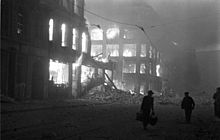
Fires after an air raid on Berlin (1944)
Soviet attack plan
On April 1, 1945, Stalin had ordered the two most important supreme commanders to Moscow: Marshals Zhukov and Konev. Troops of Zhukov's 1st Belorussian Front had won the battle for Küstrin and formed a bridgehead 44 kilometers wide and up to 20 kilometers deep on the western bank of the Oder River. From here the main thrust on Berlin was to be made. The wings of Zhukov's front were to encompass Berlin to the north and south.
The 1st Ukrainian Front Konews, which connected to the south from Guben, was to attack the defending German 9th Army there after breaking through in the rear. Stalin gave his commanders two days to work out a plan of attack on Berlin. The main thrust from Küstrin straight toward the Reich capital favored Zhukov - Konev was to shield the direct attack and encirclement of the city only by his advance to the southwest. Stalin, however, conceded to Konev that in the event of a swift action he could also penetrate Berlin from the south.
"(Stalin) drew a dividing line between Zhukov's and Koniev's army groups. The line began east of the Oder, crossed the river and continued straight ahead. It suddenly broke off at Lübben on the Spree, barely 60 km southeast of Berlin. 'Whoever advances to that point first shall conquer Berlin,' he declared."
- Gosztony: The Battle for Berlin in Eyewitness Accounts
On April 3, 1945, the date of attack was decided for April 16, 1945. A few days later, detailed instructions from High Command Stavka went to Zhukov, Konev, and Marshal Rokossovsky. "In total, the three Russian fronts were 1,593,800 strong."
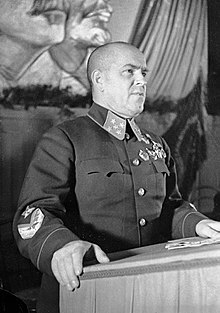
Marshal Zhukov (1941)
Battle of the Oder
The Red Army prepared a pincer attack to encircle Berlin. To capture the city, the Stavka concentrated about 2.5 million soldiers (including non-combatant units), 6,250 tanks and self-propelled guns, 7,500 aircraft, and 41,600 artillery pieces.
The 2nd White Russian Front under Marshal Konstantin Rokossowski was located on the northern section of the Oder between the Baltic Sea coast via Schwedt to Oderberg. It was located at a section of the river that was difficult to bridge and was to attack only later, after the breakthrough of the more southern army groups across the Oder. In the western Oder bridgehead from Küstrin to Guben, the 1st Belorussian Front under Georgi Zhukov was concentrated; it was to force a direct advance on Berlin. In the southern section along the Neisse River, the 1st Ukrainian Front under Konev prepared its breakthrough between Forst and Muskau in the direction of Cottbus and Spremberg.
Facing the Red Army were heavily battered units of the German Army Group Vistula under Colonel General Gotthard Heinrici, composed of the 3rd Panzer Army and the 9th Army. In the south, the 4th Panzer Army of Army Group Center was also caught in the Soviet attack. The German army troops were subordinated to strong proportions of Waffen-SS and General SS, furthermore, as "Germany's last contingent" also Volkssturm units, consisting of militarily inexperienced and ill-prepared youths between 14 and 16 years of age as well as men up to 60 years of age. These forces, which were extremely disparate in terms of experience and motivation, comprised a total of about one million men. However, they had only about 800 tanks, had to fight effectively without air support (their opponents had air superiority) and were further limited in their effectiveness and flexibility due to the poor supply of fuel and ammunition.
On April 16, the Red Army opened its offensive with the heaviest artillery fire of the war; statistically, there was one gun for every five meters along the Oder front. This shelling was largely ineffective, however, since Heinrici had withdrawn his forward positions in the area of Zhukov's main attack to the Hardenberg position on the heights on the western edge of the Oderbruch near Seelow.
→ Main article: Battle of the Seelow Heights
On the very first day, Zhukov, impatient with the difficulties of his infantry in the Oderbruch, had ordered the deployment of his two armored armies still east of the Oder in the middle section and caused even greater confusion by the ensuing intermingling of troops: "When the combined forces of all branches of arms failed to keep to Zhukov's unrealistic timetable, the fierce tank attacks compounded the consequences of the fundamental miscalculation." It was not until April 19, 1945, that the 1st Belorussian Front captured the Seelow Heights after suffering heavy losses. The Germans were thus pushed back to the outer defenses of Berlin and their reserves were exhausted.
The more southerly attacking 1st Ukrainian Front under Marshal Konev, on the other hand, was able to quickly break through the German defensive line on the Lusatian Neisse River south of Cottbus near Spremberg in the Cottbus-Potsdam operation. With a daring tank attack in the rear of the 9th Army, Colonel General Rybalko's 3rd Guards Tank Army reached Lübben, and on April 17, Konew received permission from Stalin to attack Berlin from the south. Stalin himself then communicated this to Zhukov.
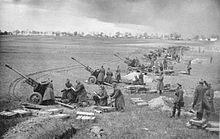
Soviet artillery in front of Berlin (April 1945)

Volkssturmmann with rocket-propelled grenade ("Panzerschreck") in front of Berlin (April 1945)
Outer defense ring
The "outer defensive ring" was not a gapless line, but was mostly manned only in a base-like manner at bridges and important road intersections. The defense was not coordinated, since neither the command in the city was regulated nor the existing units were distributed according to plan. In addition to local commanders, Joseph Goebbels acted as an organizer in the meantime.
April 20, 1945
In the northeast, a further breakthrough into the Berlin apron had already taken place in the morning with the capture of Bernau, the 5th shock army was in front of Strausberg and occupied Altlandsberg at night.
The 3rd shock army fired into the city (on Hitler's birthday) with large calibers:
"The terrain gains made by Soviet troops on April 20 were sufficient to bring long-range artillery of the 79th Corps of the 3rd Shock Army and the 1st Battalion of the 30th Guards Artillery Brigade of the 47th Army into action against the outskirts of Berlin. The first salvos on the urban area were more of a defiant gesture than a tactical move. Soviet railroad engineers were employed to guide heavy German siege artillery (shells of half a ton) captured in Silesia from Küstrin by rail to the outskirts of Berlin for use against the city."
- Tony Le Tissier
Also justified with Hitler's birthday "Anglo-American bombers flew Salut, a so-called 1000-bomber attack against Berlin, which lasted two hours. The attack altitude of these formations was chosen in such a way that an intervention of the German flak became impossible. [...] The bombers left Berlin stunned, silent and destroyed. [...] Water was available only at the pumps in the street, so that queuing for water in the open became a survival risk during the rest of the battle for Berlin."
The 2nd Belorussian Front began its attack north of Schwedt to the mouth of the Oder River from the Stettin bridgehead.
As late as the night of April 21, Konev was still driving his tank commanders through the disintegrating German 9th Army in southern Berlin-without regard for the "vulnerability of his stage" or the connection to the infantry that followed.
April 21, 1945
In the morning, in the central section of Zhukov, the 2nd Guards Tank Army (General Bogdanov) crossed the highway ring and turned on a broad front against the city area (Hohenschönhausen - Marzahn - Hönow).
A unit of the 5th shock army, which also belonged to Zhukov's troops, was the first to cross the city border in northeast Berlin near Marzahn. Its commander, Colonel General Nikolai Erastovich Bersarin, thus assumed the office of city commander in accordance with Russian military tradition. The 3rd Shock Army reached Weissensee and to the south the 8th Guards Army (General Chuikov) and the 1st Guards Tank Army (General Katukov) swung into the Erkner area.
"Around 11:30 a.m., the Soviets began shelling the city center with siege guns and heavy artillery." The fire at this distance surprised everyone in the city and dramatic scenes ensued: In the city at noon, artillery shells tore through many of the surprised people - as at Hermannplatz in Neukölln. Meanwhile, the light, gas and water supply had failed throughout the city.
The German LVI Panzer Corps withdrew to the Marzahn-Köpenick line. It lost contact with the 9th Army southeast of the city. Hitler interpreted this retreat as high-handedness and ordered the shooting of Commander Weidling. Hitler began planning a large-scale counterattack while still discussing the situation with Schörner and Wenck.
Konev's surprise success: while Konev's armored spearheads continued on their way to southwest Berlin on Reichsstrasse 96, the 3rd and 5th Guards Armies of the 1st Ukrainian Front captured the towns of Spremberg (April 21) and Cottbus (April 22), which were far in the rear.
Towards evening, Rybalko's tanks with the 6th Guards Tank Corps had already reached Zossen, where they excavated the Army High Command (OKH). Its personnel and material had been moved south in a convoy of vehicles and shortly thereafter were accidentally "successfully" bombed by the German Luftwaffe.
On the evening of April 21, the enclosure of the German 9th Army at Königs Wusterhausen was completed by Konev's 3rd Guards Tank Army together with troops of the 1st Belorussian Front coming from the northeast: "The troops of the two fronts, however, did not yet realize that they were separated from each other only by the extensive watercourses."
Berlin, which at first was only to be heckled, was now attacked directly to the south as a result of Konew's success. His target was the Spreebogen with the central government buildings. Zhukov still had no knowledge of Konev's positions in his approach to Berlin.
April 22, 1945
After Konew's advance units occupied Zossen, the first units approached the Teltow Canal at the southern city limits near Teltow. On the right wing, "troops of the 9th (mech.) Corps crossed the highway ring around 9:00 a.m. and reached (in the evening) Lichterfelde, Marienfelde and Lankwitz. [...] The tanks rolled down all resistance and entered the residential areas." Konev had outflanked Zhukov in the southern suburbs, but he was in urgent need of a concentration of forces on April 23 - "for the attack on the inner city, which he wanted to lead himself."
By late afternoon on April 22, the 8th Guards Army under Zhukov's General Chuikov in the southeast had "captured the suburbs of Dahlwitz, Schöneiche, Fichtenau, Rahnsdorf, Friedrichshagen, and Wendenschloß." During the night they reached Grünau and Falkenberg.
Zhukov's troops used the day to prepare for street fighting or were "led around the northern districts to their assigned sections for enclosing the city."
On the night of April 23, the 47th Army had already crossed the Havel River at Hennigsdorf and was now ordered to "finally enclose the town and advance a line of defense as far west as possible."
In the northern arc, Zhukov's forces advanced to Reinickendorf and Pankow; in the east, they stood in Weissensee, Lichtenberg, Karlshorst and Köpenick.
"The night of April 22-23 was a significant break in the progress of the battle. Both sides were forced to rethink how to get a grip on the situation. The Russians had been given a taste of what the next phase of the operation would bring [...] The Germans, belatedly, had to prepare for a siege with all its consequences."
- Tony Le Tissier: The Battle for Berlin 1945
.JPG)
The picture Memorial April 21, 1945 was designed by Otto Schack.
.JPG)
Architectural monument Landsberger Allee 563
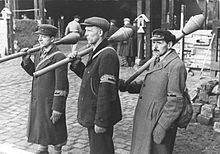
Volkssturm soldiers
Operations of the 2nd Belarusian Front
The task of the 2nd Belorussian Front under Marshal Rokossowski in the planning of the High Command was to attack the German lines from the Zhukov section near Schwedt to the mouth of the Oder River at the Great Lagoon starting from the second phase of the large-scale attack from the Oder River:
"Although Rokossovsky's operation had no direct impact on the Battle of Berlin, it did tie up the forces of the 3rd Panzer Army and thus precluded shifts of forces to other sections of the front. As a result, it contributed not insignificantly to the collapse of the German Oder Front."
- Tony Le Tissier: The Battle for Berlin 1945
From 18 April, Rokossowski's troops advanced from the Szczecin bridgehead through the flooded marshes and launched the Szczecin-Rostock operation. Beginning on April 20, the attack began on the defending 3rd Panzer Army of General Hasso von Manteuffel. The latter's last tanks had been ordered by Heinrici to the southern section near Eberswalde to halt Zhukov's advance there. Given the lack of equipment, Manteuffel described his troops as "the purest ghost army." He also had no artillery at his disposal, only 600 anti-aircraft guns, some of which were encased in concrete.
The attack began with artillery preparations, but only the 65th Army under Colonel General Batow was able to form a stable bridgehead on the west bank of the western arm of the Oder. The general: "On April 20, the enemy counterattacked twenty times [...] (Since he) brought his reserves into the fray from the movement and, in addition, in separate parts one after another [... he could not] form a thrust wedge; their improvised attacks, however, did them little good, although they were often and bitterly repeated." Massive counterattacks, also with tanks, were recorded by Batov until April 24.
As early as April 22 Zhukov learned "that the instruction (of the Stavka) to Rokossovsky, according to which the 2nd Byelorussian Front was to attack from the north to bypass Berlin, had been cancelled."
"The 3rd Panzer Army was still desperately defending its positions on the Oder River on April 23, despite heavy pressure. Colonel General Heinrici was aware that General Manteuffel's troops would not hold out much longer. He therefore planned to take them back to the other side to enable them to surrender to the Western Allies." On the southern flank, Steiner had been bypassed at Oranienburg and had to go back to the Ruppiner Canal.
On April 24
"(was) from Army Group Vistula [...] practically only Manteuffel's 3rd Panzer Army left. Manteuffel put up fierce resistance, but the central section was already giving way dangerously. Even worse, Zhukov's tanks, advancing along the southern flank, could now swing north and trap Manteuffel. The only force standing in their way was SS-Obergruppenführer Felix Steiner's bunch."
- Cornelius Ryan: The Last Stand
"During the night (of April 26-27) the 3rd Panzer Army withdrew from its positions from the south-to-north running Ücker in Prenzlau, giving up the last chance for a closed defense."
Rokossowski's 2nd White Russian Front subsequently occupied Western Pomerania (Stralsund - Rostock), Mecklenburg (to just before Schwerin), and northern Brandenburg (Wittstock - Wittenberge). On May 5, units of this front occupied Peenemünde; others met troops of the British 21st Army Group at the end of the war, which had advanced across the Elbe River in some places.
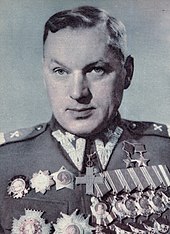
Marshal Rokossowski (1949)
German planning
At Hitler's instigation, the commander in Berlin, Lieutenant General Hellmuth Reymann, had ordered in the basic order of March 9, 1945, that Berlin be defended "to the last man and to the last cartridge."
For the Reich government, Reich ministries and the security apparatus, evacuation measures had already been prepared since February, but they were not carried out until April 1945, so that they would not have to admit defeat prematurely. Hitler issued the Clausewitz Case on April 20, 1945, which, in view of the approaching front, ordered, among other things, the evacuation of all Berlin buildings and areas in which government, Wehrmacht and SS offices were housed, as well as the destruction of official files, documents and papers. Immediately, files were destroyed in the offices and large columns of trucks were formed with personnel and valuables. The majority of the staffs to be evacuated were to head north. Only Hermann Göring, after Hitler had decided to remain in Berlin on April 22, went with his staff to southern Germany.
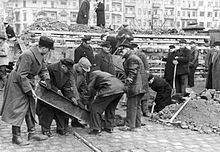
Volkssturm men dig steel girders to reinforce an anti-tank barrier at Hermannstrasse S-Bahn station in Neukölln on March 10, 1945
German defense
After four days of hard fighting, the German Oder Front was broken on April 19, 1945. "To close the gaps yet was hopeless. The struggle of the Army Group and the Army High Command for permission to dismount continued without success. [...] Into this desperate situation burst Hitler's completely absurd order, ..." with a combined major attack by the 9th Army and 4th Panzer Army, "to cut off the rearward links of the 1st Ukrainian Front and bring its thrust on Berlin to a halt. The army passed over this impracticable order and made the decision, now even without orders, to initiate all measures for a push through the southern group to the west." Thus began the attempts of the German commanders to evade Hitler's orders.
While Hitler was considering going or staying in the Reich capital on his birthday, April 20, and pinning his hopes on Panzer General Walther Wenck's 12th Army, Heinrici was consistently trying to lead the remnants of his shattered Army Group in retreat south and north around Berlin. On April 29, when he wanted to "transfer the affairs of the commander-in-chief of Army Group Vistula" to General von Manteuffel - who refused - Heinrici was replaced by Field Marshal Keitel with General der Infanterie von Tippelskirch.
In Berlin, on April 21, Hitler replaced General Reymann as combat commander of Berlin with Colonel Kaether. When General der Artillerie Helmuth Weidling, commander of the LVI Panzer Corps, appeared before Hitler on April 23 to personally protest his firing on the basis of high-handed actions, he was included in the briefing: "With ever-increasing astonishment I listened to the Fuehrer's grandiloquence." He was appointed by Hitler the following day as the new 'commander of the defense of Berlin'. Weidling said to General Krebs, who informed him of the appointment, "It would be better if you had ordered me to be shot, then this cup would pass me by!"
Weidling took over command and the division of Berlin into nine defensive sections. He reorganized the distribution of troops and endeavored to distribute regular troops, the "detachments of the Volkssturm and ragtag formations of all kinds" in a militarily sensible manner.
Participation of troops from other nations
180,000 Polish soldiers also took part in the attack on Berlin and the fighting against Army Group Center. In the north, the Polish 1st Army shielded the outer wing of the 1st White Russian Front against General von Manteuffel's 3rd Panzer Army and then overcame Army Group Steiner. The Polish 2nd Army fought in the south against remnants of Army Group Center under Field Marshal Ferdinand Schörner.
"Under Hitler's flag, representatives of almost all European peoples fought in Berlin as remnants of the 'European' SS units. We find Belgians, Dutch, Danes, Norwegians, Swedes, Estonians, Latvians, Ukrainians, Galicians, Transylvanians, Swiss, French and Spaniards. The most numerous were French and Spanish." Among them were the ninety Frenchmen of the Remnant Division Charlemagne, "who wanted to continue fighting not for Hitler but for Europe against the Soviets."
- Erich Kuby: The Russians in Berlin 1945
Thus, as historian Anthony Beevor commented, "the fall of Berlin became a funeral pyre for the remnants of the European far right."
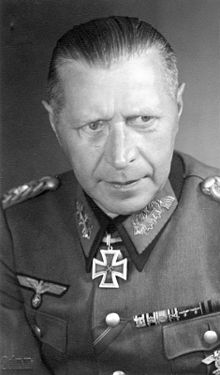
Helmuth Weidling, commander of the defense of Berlin (photo: January 15, 1943)
Location in the city
The civilian population of Berlin was estimated by the military authorities at the beginning of the Battle of Berlin to still be about 2.7 million. In 1939, 4.3 million people had been counted; now it was almost 40 percent less. Of the remaining inhabitants, about two-thirds were females of any age. The third of the male civilian population was made up primarily of children and adolescents up to the age of 16 and older men over 60. A large proportion of Berlin's former inhabitants were no longer in the city, if not as soldiers on various fronts or prisoners of war, then through evacuation or flight - usually to the west (see also Kinderlandverschickung). In the eleven weeks before the battle, about 200,000 people had also been induced to flee Berlin or killed by 85 air raids, mostly by British or U.S. bombers. Berlin already resembled a rubble landscape at the beginning of the Red Army's land offensive on districts in the center.
In these last days of the war, there was widespread destruction of buildings and the transportation infrastructure. For example, the Karstadt department store at Hermannplatz and the north-south tunnel of the S-Bahn under the Landwehr Canal were blown up under unclear circumstances. (→ History of the Berlin subway)
During these April days, fanatical National Socialists and SS leaders used summary courts and firing squads to force a continuation of the fight to the end. The hopeless defense of Berlin was propagandistically whipped up by Goebbels, who, together with the State Secretary of the Propaganda Ministry, Werner Naumann, published the combat bulletin for the defenders of Greater Berlin entitled Der Panzerbär. These bulletins called for loyalty to the "Führer" and at the same time raised hopes for a final victory.
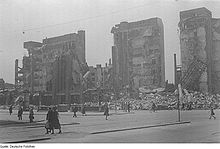
Ruin of the department store Karstadt at Hermannplatz
Inner defense ring
April 23, 1945
In addition to the deployment in the east, the northern encirclement of Berlin by Zhukov's troops allowed for several attack wedges toward the city center. In the south, Konew's troops stood in front of the Teltow Canal.
North
The front line of the attack in the northwest on the Havel River was formed by the 47th Army, to which the 9th Guards Tank Corps, the 7th Guards Cavalry Corps, and the 1st Polish Mortar Brigade were attached. By the evening of 23 April, the first units were on the outskirts of Nauen.
In the Tegel section, three days of fighting began on April 23 with a factory guard battalion, which then retreated to Wittler's bread factory in Wedding. However, other Soviet troops bypassed the position to Hermsdorf, Waidmannslust and Wittenau - further east, the 12th Guards Corps advanced via Lübars, Blankenfelde, Rosenthal to Reinickendorf and fought for Pankow City Hall. The 79th Army Corps of the 3rd Shock Army was in Niederschönhausen.
East
The 5th Shock Army fought in the area of Schlachthof Storkower Strasse (26th Guards Rifle Corps) and on the S-Bahn line around Ostkreuz station (32nd Rifle Corps). The 9th Rifle Corps took Karlshorst with its pioneer school. "By the evening of April 23, the combat units of the 8th Guards Army had taken the districts of Karlshorst, Uhlenhorst, Schöneweide, and Köpenick and were fighting west of the Dahme River."
"In the evening, the boats of the Dnieper flotilla also reached the scene to support the troops crossing (the Spree) [...] and to attack Berlin (also) from the south."
Competition Zhukov - Konev
"They were far behind schedule, Stalin was pushing, and Zhukov must have been concerned about Koniev's progress."
Konew's 3rd Guards Tank Army regrouped that day and "closed in on the advance divisions south of the outer defensive ring between Stahnsdorf and Lichtenrade." Now here Konew greatly overestimated the forces of the defenses behind the Teltow Canal and allowed his oversized artillery effort to delay him.
The failure prompted Stalin to clarify the task of his field marshals:
"From this day, April 23," read the order (No. 11074), "the border between the 1st Belorussian Front and the 1st Ukrainian Front will run from Lübben via Teupitz, Mittenwalde, Mariendorf to Anhalter Bahnhof. Konyev was deeply disappointed: Stalin had awarded Zhukov the victory prize. The border line, which ran straight through the city, forced Konyev and his troops to stop about 140 meters west of the Reichstag, on which the Soviet flag was to be planted."
- Cornelius Ryan: The Last Stand
The main task of Konew's army group was thus again the advance south of Berlin. Thus, his troops reached Potsdam, Beelitz, Lehnin and moved towards Torgau on the Elbe. In addition, there was the advance in the direction of Bautzen and Dresden.
April 24, 1945
North/East
The 12th Guards Tank Corps occupied the Jungfernheide area (now Tegel airfield) as far as the Hohenzollern Canal - but suffered heavy losses at night in the Siemensstadt industrial complex. The 79th Corps was held up by resistance around Plötzensee Prison and at Westhafen.
"The 12th Guards Corps began to seep into the workers' district of Wedding." At Bahnhof Wedding, a key position in the inner defensive ring, the breakthrough came only after heavy artillery was used. The Humboldthain with its flak bunker was bypassed and sealed off, and the garrison fought to the end.
Little resistance was encountered by the 7th Corps in Prenzlauer Berg; the inner defensive ring was breached in the direction of Alexanderplatz.
The 5th Shock Army (26th Guards Corps, 32nd Corps) advanced along Frankfurter Allee - stronger resistance occurred in the area of effect of the Friedrichshain Flak Tower. The 9th Corps of the 5th Shock Army crossed the Spree River at the height of Treptower Park in the early morning hours of April 24. 16,000 men were crossed by the Dnieper flotilla. Resistance was formed against this by the SS Volunteer Division "Nordland".
"The 301st Rifle Division took possession of the Rummelsburg power plant - undestroyed and ready for operation."
South
From Konew's southern encirclement of Berlin, the attack across the Teltow Canal began in the early morning of April 24 after 55 minutes of artillery fire, which, despite the inferiority of their forces (at Lankwitz), "after initial successes, (was) repulsed by the German defenses with heavy Soviet losses and the abandonment of the Russian bridgehead." In the center, Konew's troops were more successful in the transition and were able to bring the southern part of Zehlendorf under control by evening. The defenders withdrew to Wannsee Island.
In the south of Berlin, the Red Army reached the eastern suburbs of Potsdam and the Brandenburg - Wittenberg line.
Fuehrer position (Reich Chancellery)
German staff officer Gerhard Boldt, who had been detached to Berlin from April 22 to prepare Hitler's situation briefings, noted in his memoirs of the day:
"Noon: [airport] Tempelhof under fire, fails, 5 p.m. also Gatow, expansion of east-west axis [as runway], reinforcement shelling center (evening), [...] night of April 25: amalgamation OKW/OKH, news of enclosure [of city]."

Siemensstadt
Encirclement and advance to the center
April 25, 1945
South of Stettin, the 2nd White Russian Front forced the 3rd Panzer Army to retreat. "Heinrici immediately gave Manteuffel the desired permission to withdraw and specifically ordered the 'Fortress Stettin' to be evacuated." He then informed the OKW, which "took forty-eight hours (for) an indignant Keitel to call him."
In Berlin, General Weidling, appointed city commander by Hitler on April 24, began reorganizing the defenses.
Marshal Novikov, the commander of the Soviet air fleet, set
"staged a large-scale air operation against Berlin under the name of 'Operation Salute'. A first strike was carried out by bombers of the 18th Air Army; it was followed by non-stop air attacks all day long by the 16th Air Army. All told, 1368 planes were in action-including 569 dive bombers (Pe-2) used on specially designated targets."
- Novikov: The role of the air force
Also on April 25, the Russians and Americans met on the Elbe River near Torgau.
Enclosure of Berlin
The southern encirclement by Koniev's front with the 4th Guards Tank Army (General Lelyushenko) also included Potsdam. Along the way, the 6th (Mech.) Guards Corps met the 47th Army (General Perchorovich) from Zhukov's front approaching across the Havel River on April 25, 1945, west of the Reich capital at Ketzin/Havel. Thus the ring around Berlin was finally closed. Until the end, however, the western side of Berlin, obscured by lakes and forests, remained incompletely occupied.
In the west, Spandau's garrison broke out toward the city center on the night of April 25-26.
In front of the city center
North: Fighting took place around Siemensstadt from 25 to 28 April. The 79th Corps won the Plötzensee Penitentiary and was pinned down at the Westhafen Canal. The 12th Guards Corps took the undestroyed Fenn Bridge in Moabit in a hand coup. The flak tower Humboldthain hindered the advance in the northeast. There was also stiff resistance north of Invalidenstrasse, with the 7th Corps reaching Alexanderplatz.
East: The 5th Shock Army made slow progress in Friedrichshain. Zhukov later described the capture of the Schlesischer Bahnhof (now Ostbahnhof) as one of the "most difficult tasks."
South: The 8th Guards Army and the 1st Guards Tank Army advanced across the Teltow Canal to Tempelhof and west of the Tempelhofer Dam. To the southeast, Soviet troops infiltrated Neukölln. Colonel General Rybalko's 3rd Guards Tank Army fought in the southwestern suburbs along the S-Bahn ring and advanced through the Botanical Garden to Schmargendorf, Nikolassee, and Dahlem to Grunewald. A wedge pushed through Steglitz to Schöneberg.
Konew began a concentration of troops with the intention of an advance to PotsdamerPlatz.
Führer position Reich Chancellery
"The artillery effort of the Russians increased almost hourly. 6 p.m.: Peaks in Zehlendorf and deep in Neukölln. Berlin only 'supply bombs. [...] Inquiries about the 'morale of the troops'."
April 26, 1945
Southwest: Colonel General Wenck's 12th Army formed up toward Potsdam (instead of Jüterbog) and reached Beelitz. Konew had to get his 10th Guards Tank Corps free to oppose Wenck. In southwestern Berlin, street fighting began in the densely built-up areas.
West: After reaching Heerstraße, parts of the 3rd Guards Tank Army "swung to the right toward Charlottenburg and began to advance slowly through the residential districts on both sides of this wide thoroughfare. Defense resistance increased only when their unexpected appearance was noticed."
South: After a final counterattack in Neukölln, the Nordland Division retreated to the city center the next morning. After capturing Tempelhof Airport, Tschuikow's troops occupied Viktoriapark (the next day Anhalter Bahnhof was shelled on sight). The left wing advanced via Yorckstrasse to Kleistpark and reached Kurfürstenstrasse via Potsdamer Strasse by evening. On the night of April 27, the right wing was in front of the Landwehr Canal, whose bridges had been blown up shortly before.
North: With strong support from Marshal Novikov's air fleet, the Westhafen Canal was overcome and by evening much of Moabit was in Soviet hands. Alexanderplatz was still fiercely fought over.
Führer situation (Reich Chancellery):
"In the morning: ammunition situation / deployment JU 52 / Teltow canal line overrun [...] Neukölln southern edge airport / Weißensee / Reinickendorf / Tegel lost / fighting Stettiner- and Görlitzer Bahnhof / towards evening Charlottenburg [...] telephone book surveys:"
"In their multiplicity, they gave a fairly complete picture and were much clearer in the result than the sometimes rather confused reports from the troops."
- Gerhard Boldt: The Last Days in the Reich Chancellery
April 27, 1945
South:
Chuikov put in a kind of rest day for his troops in preparation for the canal crossing. Shelling also largely ceased. The 28th Guards Corps under Chuikov bypassed German positions at Nollendorfplatz and Lützowplatz to advance as far as Budapester Strasse: "Some Soviet tanks managed to break through to the zoo area and from there opened fire against the flak towers." This advance virtually deprived Konew's 3rd Guards Tank Army, which was engaged in heavy fighting around Fehrbelliner Platz, of any possibility of taking the Reichstag before Zhukov's troops did.
West: On April 27, Gatow airfield was finally lost: The day before, Hanna Reitsch flew from the airfield with Colonel General Robert Ritter von Greim to the Führerbunker in Berlin, which was already completely surrounded.
Soviet troops captured the entire west bank of the Havel. The fighting in Charlottenburg increased in ferocity, for Weidling, "in order to keep open a sally port to the west, had detached part of the 18th Panzer Grenadier Division to support the local defenses." The 79th Corps in Moabit, which continued to advance slowly (even against the Vlasov units), was already aiming for the Spreebogen with the Reichstag.
The 5th shock army fought between Spree and Alexanderplatz - the 9th Corps on the other side of the river entered Kreuzberg and reached Moritzplatz along Oranienstrasse.
After the dissolution of Manteuffel's 3rd Panzer Army in the north and Steiner's abandonment of any offensive movement, "the only realistic hope left for the defenders of the city of Berlin [...] was directed at Wenck's 12th Army, which could open an escape route to the west [and ...] was (was) only about ten kilometers from Potsdam."

Flak tower Zoo 1942; the flak was used in ground combat in 1945
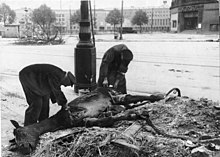
Residents dismantle a horse (Tempelhof Airport)
Center fights
April 28, 1945
"On April 28, the Russians entered the center of the city."
In front of the Landwehr Canal opposite Anhalter Station, Soviet reconnaissance continued all day. The S-Bahn and U-Bahn lines under the canal were barricaded and unusable for the advance.
The 79th Corps in Moabit, followed by the 2nd Guards Tank Army, reached the Moltke Bridge at the Spreebogen and prepared to storm the government quarter.
From the southeast, the 32nd Corps of the 5th Shock Army attacked Fischerinsel, and the 9th Corps occupied the area around Spittelmarkt.
At this time, the Luftwaffe's last operations were carried out despite the lack of fuel. The last German reconnaissance flight of the war passed the Landwehr Canal at 16:30 and reached the Soviet headquarters, where the plane was eventually shot down due to lack of training of the pilot. By the end of the Battle of Berlin on May 2, Soviet air forces would maintain air superiority.
On April 28, Konev and the 3rd Guards Tank Army had made a final attempt from the west to advance to the 'Citadel' via Savignyplatz and Zoo: "The main attack proceeded as planned, and only later in the morning did it suddenly become apparent that almost the entire eastern half of the attack front was occupied by Chuikov's formations, which are unlikely to have welcomed Koniev's artillery preparation."
Fight for the Reichstag
For the Soviet side, from Stalin to the simplest soldier, the Reichstag embodied Nazi fascism. It was the symbolic target of attack.
On April 28, the commander of the 79th Rifle Corps, which belonged to the 3rd Shock Army, Major General Perevyortkin, received orders to capture the Reichstag. During the night of April 28-29, Soviet troops advanced across the half-destroyed and barricaded Moltke Bridge over the Spree River. Continuing the attack, by the evening of April 29 they captured the former General Staff building used by the Reich Ministry of the Interior, which they called "Himmler's House." In the morning hours of April 30, the shelling of the Reichstag began from here, and from 2 p.m. on, the direct attack across Königsplatz. By the evening, the upper floors had fallen; fighting continued in the basement.
"The pressure Stalin exerted to see the Red Flag fly at the Reichstag for the May Day celebrations was so great that no one in the chain of command even wanted to expose himself to the suspicion that he was sabotaging this goal. Casualties no longer mattered from then on."
- Tony le Tissier: The Battle for Berlin 1945
April 29, 1945
Northwest: "On the morning of the 29th, a breakthrough was made in the 2nd Guards Tank Army section;" - the ruins of Charlottenburg Palace were occupied, the defenses at Jungfernheide S-Bahn station were overcome, and the spit of land at the confluence of the Spree and Landwehr Canal was tackled.
Norden: "The attack of the 79th Corps (during the night) across the Moltke Bridge was a foolhardy and bloody enterprise" - since the Lehrter freight station had not yet been captured, counterattacks and a partial destruction of the bridge occurred from there. By dawn, however, a bridgehead had been formed in a block of houses on the other side of the river: "The 150th Division was preparing to advance across Moltkestraße to the main entrance of the Ministry of the Interior, 'Himmler's House,' as they called it. [...] The fighting moved rapidly up the main staircase to all floors and continued throughout the day and night. [...] Between 8:30 and 10:00 there was heavy artillery fire on the positions at the Reichstag."
Northeast: Strong resistance at the fortified Szczecin train station (today: S-Nordbahnhof), in the city center the Red City Hall was stormed.
Southwest: The advance in Wilmersdorf, aimed at the Zoologischer Garten area and the anti-aircraft bunker there, turned into a "muddle" for the Soviet troops, since the front line, which changed at night, was located here and Konew's and Zhukov's troops "got entangled" in the context of the fighting. They could be reorganized only in the following night.
On the southern front in the city, the battle was fought for Potsdamer Brücke, which was only partially destroyed. Towards evening, the way to Potsdamer Platz was cleared.
With the crossing of the Landwehr Canal over the rubble of the Möckernbrücke elevated train station in the course of April 29 - later tanks could be trailed over a pontoon bridge at Hallesches Tor - Zhukov's troops reached their "point of orientation where the two attacking fronts collided."
However, a battle for Anhalter Bahnhof did not take place - the huge number of refugees there kept both sides from doing so, especially since defenders and attackers concentrated on the next position around the Aviation Ministry (today Detlev Rohwedder House). Dramas played out in the Anhalter Hochbunker and underground in the S-Bahn facilities.
On the evening of April 29, Hitler had
"[...] Mohnke come, who is responsible for the defense of the 'Citadel' [... he reports:] In the north the Russian is just before the Weidendammer Bridge. In the east at the Lustgarten. To the south at Potsdamer Platz and the Aviation Ministry. To the west at Tiergarten, 300 to 400 meters from the Reich Chancellery. Hitler went on to ask, 'How long can you hold?' 'At most another 20 to 24 hours, my Führer, no longer.'"
- Gosztony: Eyewitness accounts
Hopes for relief
Wenck could not and would not carry out Hitler's order to break through to Berlin, which had been delivered personally to Wenck on April 23 at the "Alte Hölle" forester's lodge near Wiesenburg/Mark in the Fläming region by Field Marshal Wilhelm Keitel, Chief of the Supreme Command of the Wehrmacht. Although the German 12th Army under Wenck was able to advance once again to the Ferch area and pick up the remnants of the German 9th Army that had broken out of the Halbe encirclement and 15,000-20,000 soldiers from encircled Potsdam at the end of April, Wenck's operations were ultimately aimed at keeping open the way to American captivity for the German units encircled at Halbe and then fighting their way toward Beelitz.
The battles in Berlin turned out to be a fierce fight for houses. Often there was a fierce fight for only a few buildings or for the railroad lines. The Soviet units were constantly exposed to snipers and fighters with bazookas in the city area. According to Konew, the Red Army lost about 800 tanks against the regular troops and the fighters of the Volkssturm and Hitler Youth equipped with anti-tank weapons. However, the superiority of the Red Army was too strong, so that the German defenders often could not hold their positions for long and then had to retreat.
On the night of April 30, Hitler received a radio message from Colonel General Alfred Jodl (Chief of the Wehrmacht Joint Staff), "Spitze Wenck liegt südlich Schwielowsee fest. 12th Army therefore cannot continue attack on Berlin. It was thus clear that there would be no relief.
Hitler's Nero orders
Most of the city's food supplies had been destroyed on Hitler's orders. 128 of the 226 bridges had been blown up and 87 pumps rendered inoperative. "A quarter of the subway shafts were under water, flooded on Hitler's orders. Thousands and thousands who had sought shelter in them had drowned when the SS had blown up the Landwehr Canal shelters. Workers had sabotaged and prevented the blasting of the Klingenberg power station, the Johannisthal waterworks and other pumping stations, railroad facilities and bridges prepared by the SS at the last minute.
.jpg)
City center, Anhalter train station at the bottom right

Destruction in Berlin-Mitte not far from the street Unter den Linden
Battle for the "Citadel
The intensity of the fighting in Berlin increased toward the end, according to reports from both sides; on the German side, it was concentrated on the core of the defenses in the Spreebogen and the attempt to keep the way clear to the west.
In the citadel "(faced) the Soviets [...] an estimated 5000 men, mostly SS units, but not only Waffen-SS. Two battalions of Volkssturm, the battalion 'Grand Admiral Dönitz', raised in Stralsund from naval officer candidates and hastily brought to Berlin, and some smaller units of the 9th Parachute Division completed the German defense. These forces were supported by light artillery and field guns, a number of the famous 88-mm anti-aircraft guns and mortars."
Hans Fritzsche noted a much stronger occupation in the center, which he walked:
"On the night of May 1, I ran to various fighting groups [...] in the small quarter between Gendarmenmarkt, Reichstag, Friedrichstrasse station and the Aviation Ministry. I had the impression that well over 10,000 men were standing here, not counting the SS units in the Reich Chancellery, which surely also numbered 2000 to 3000 men."
The commander of the citadel was SS-Brigadeführer Wilhelm Mohnke.
Polish Division
As the only formation besides the Red Army, the 1st Polish Infantry Division "Tadeusz Kościuszko" under General Bewziuk took part in the storming of the center of Berlin. Formed in Lenino in May 1943, the unit was engaged in street fighting in northwestern Berlin with General Marian Spychalski. It still had special experience in street fighting from battles in Warsaw and Praga, respectively, and advanced in formation with General Semyon Bogdanov's Soviet 2nd Guards Tank Army. The Kościuszko Division advanced along New Kant Street to Karl August Square. It took part in the capture of the Technical University, the Tiergarten S-Bahn station, and four other subway stations. It fought further battles along Franklinstraße, Englische Straße, Salzufer, as well as in Tiergarten and at the rear of the Reich Chancellery.
April 30, 1945
Battle for the Reichstag: By 4 a.m., the 150th Rifle Division had captured the Interior Ministry and the 171st Division occupied the western half of the diplomatic quarter. The first assaults on the Reichstag via Königsplatz failed because surrounding buildings - especially the ruins of the Krolloper - were still occupied by Germans and their capture continued until around noon.
The successful attack began at 2 p.m. and at 10 p.m. of the same day the Red flag flew on the dome of the building. Soviet soldier Mikhail Petrovich Minin was the first Red Army soldier to raise the Soviet flag on the Reichstag. Although this meant that the Reichstag as a building was occupied, fighting still continued in the cellars. The photographic media icon On the Berlin Reichstag, May 2, 1945 by Yevgeny Ananyevich Khaldei was created later.
On the evening of April 30, it fell to Chuikov to inform his commander-in-chief Zhukov that Stalin's wish "to have (taken) all of Berlin by the celebration of May 1" would not be fulfilled. It was then up to Zhukov to pass this message on to Stalin.
Zoo Bunker (Flak Tower): "Terrible fighting" raged in the streets around the zoo, which was reached by Soviet troops via Schloßstraße and Berliner Straße (now Otto-Suhr-Allee): "Infantry losses had reached the staggering level of 90%, so it was decided to detach the 1st Polish Division 'Tadeusz Kościuszko' of the 1st Polish Army that night to reinforce the 2nd Guards Tank Army." Other Polish units were divided into combat groups on Soviet brigades.
West: "April 30 brought particularly fierce fighting in the districts of Charlottenburg and Wilmersdorf, as the 2nd and 3rd Guards Tank Armies converged on the S-Bahn, which formed the front line, and German troops tried to keep open a path to the western part of the city. [...] The flow to the west intensified." (Fighting in Westend)
South of the Spreebogen (Landwehr Canal): "Chuikov reports: After capturing a few small bridgeheads over the Landwehr Canal, the units of my army proceeded to storm the Tiergarten from the south."
In the Anhalter Hochbunker, the power supply failed - the darkness was alleviated only by candles. In the bunker, everything "with a swastika on it" was destroyed. The stoppage of the generator led not only to the failure of the lighting, but above all of the ventilation - as a result, the temperatures rose rapidly, 60 degrees Celsius were already measured upstairs. The situation inside became increasingly unbearable and chaotic. Suicides became more frequent. The pump at Askanischer Platz failed due to a shell hit. "On the square in front of the train station, in a sense on our doorstep, the Russian tanks are already there. “
→ Main article: Anhalter Hochbunker Berlin
German side: A Weidling report confirmed "deep wedges of the enemy [...] in the area of Potsdamer Platz and Anhalter Bahnhof [and] along Wilhelmstrasse almost to the Aviation Ministry, a wide gap between Spittelmarkt and Alexanderplatz, and fighting near the Reichstag building. Both sides of Leipziger Strasse were in the hands of the Russians."
According to General Krebs during the May 1 negotiations with General Chuikov, Adolf Hitler and his wife Eva Braun, who had been married the previous day, put an end to their lives at 3:15 p.m. on April 30, 1945.
Goebbels negotiated: After Hitler's death, disputes arose among various factions over the continuation of the fighting. Evening, April 30: General Krebs wants to negotiate and "request" an armistice for this purpose. The Minister of Propaganda "took charge" (Axmann report).
As late as 4 p.m. on April 30, General Weidling (according to his own account) received a letter from Hitler with permission to "break out of the encirclement in small groups." The permission was soon revoked by Mohnke. Appearing in person at the Reich Chancellery, Weidling learned through Krebs of Hitler's death and of Adolf Hitler's political will with the composition of a new Reich government. An armistice was now to be requested until the "new government had met in Berlin; [...] to enter into negotiations with Russia for a surrender of Germany." Shortly before midnight, a parliamentarian made contact with Chuikov's troops.

In the bunker: diesel engine of the emergency generator

Fighting for the government district and the Reichstag
May 1, 1945
"While some of the Russians are celebrating May Day, the fighting in the city center continues with unabated ferocity."
Since the Anhalter Hochbunker is considered a defense facility, it is under non-stop direct fire. Early in the morning, starting at five o'clock, the 10,000 shelter seekers are evacuated via underground passages to the Anhalter Bahnhof S-Bahn station. From there, they will be led through the tunnel shaft to the Stettiner Bahnhof station in front of the north exit. The underground train network is overcrowded with people.
"Thousands of wounded soldiers and civilians lie in the shafts and the stations of the U-Bahn and the S-Bahn. How great their number really was, no one will ever know."
First talks: At 3:50 a.m. early on May 1, General Krebs, Colonel von Dufving, Chief of Staff of the LVI Panzer Corps, and an interpreter arrived with a letter from Goebbels insisting on legal titles from Hitler's will necessary for peace negotiations. Chuikov, after some back and forth, got himself connected with Zhukov, who in turn informed Stalin. Stalin insisted on unconditional surrender and did not want any negotiations. If this was not complied with, Berlin would again be taken under artillery fire from 10:15 a.m. (on May 1).
The Spandau citadel, surrounded by Soviet troops, is surrendered after negotiations on the afternoon of May 1.
Surrender Negotiations
At 1 p.m. on May 1, Krebs returned. Axmann reported: Goebbels refused to "put his signature under a surrender document. [...] Around 8:30 p.m. I returned to the bunker of the Reich Chancellery. In the corridor I met Mohnke. He said, 'Dr. Goebbels and his wife are dead.'" Generals Krebs and Burgdorf and other military officers killed themselves.
Goebbels had also attempted further negotiations with the commander of the troops of the 5th Shock Army, who were standing in front of the Reich Chancellery. However, the colonel of the 301st Division was not authorized to conduct negotiations. However, since the matter took hours during which there was a ceasefire in this section, the storming of the Reich Chancellery, which had actually been ordered, did not take place that day.
General Weidling reported on the situation in the city in the second half of May 1: "In the hands of the Russians were: Zoologischer Garten station, Weidendamm Bridge, Spittelmarkt, Leipziger Strasse, Potsdamer Platz, Potsdamer Bridge and Bendler Bridge. Resistance in Wilmersdorf crushed, situation in the west of the city unknown."
The renewed offensive threatened by Stalin now began at 6:30 p.m. with heavy artillery and rocket fire. The 29th Guards Corps of the 2nd Guards Tank Army crossed Budapester Strasse and broke through the Zoomauer. The Kaiser Wilhelm Memorial Church was captured and the tower occupied by snipers and artillery observers. In the eastern Tiergarten, Siegesallee was reached. The capture of Potsdamer Bahnhof and Potsdamer Platz was reported. "The 66th Guards Tank Brigade cleared its section north of the Landwehr Canal and took the base at the Tiergarten S-Bahn station." The base at the Technische Hochschule was stormed. From the south, the 3rd Guards Tank Army (Konews) crossed Kurfürstendamm "and at 8:30 the following morning [May 2] the two tank armies met near Savignyplatz."
At 8 p.m. on May 1, back from another visit to the Reich Chancellery and aware of the failed attempts at negotiation, Weidling summoned the soldiers from his command post: "They all agreed with me: there was only one possible way out, and that was surrender [...] At midnight [from May 1 to May 2], Colonel von Dufving, as a parliamentarian, once again crossed our battle line."
"On May 2, shortly before 1 a.m., the 79th Russian Guards Gunnery Division intercepted a radio message. It read: 'This is LVI Tank Corps. We request that you cease fire. At 12:50 Berlin time, we are dispatching MPs to Potsdamer Brücke.' [...] The Russians replied: 'Understood. Understood. Transmit their request to Chief of Staff. When General Chuikov received the message, he immediately ordered the cessation of fire."
- Cornelius Ryan: The Last Stand

The Potsdam Bridge (in the background, only damaged on the left, here repaired) was still passable; in front the destroyed emergency cable bridge, condition October 1945
Surrender 2 May 1945
To his astonishment, Colonel von Dufving, who had now been assigned by General Weidling to declare the surrender, met with Tschuikow a civilian delegation led by Hans Fritzsche, Ministerialdirigent in the Propaganda Ministry, who offered to announce Berlin's surrender on the radio. While this was still being negotiated, General Weidling personally arrived at Chuikov's headquarters at Schulenburgring 2 in Tempelhof.
Thus, the Soviet troops were faced with a military commander who was also factually in a position to stop the fighting on the German side. According to him, he had already given the order to do so at 6 a.m. to the troops directly subordinated to him (the LVI Panzer Corps and affiliated units), but due to lack of communications he could not guarantee the general cessation of fighting.
On May 2, at 7:50 a.m., Weidling began drafting the surrender order. Loudspeaker trucks, each with a Soviet officer and a German, were sent into the city. For duplication, Weidling spoke the surrender order on tape.
The defenders in the cellars of the Reichstag resisted until the order to surrender was reached at 1 p.m. on May 2: "Only then did the 1500 survivors lay down their arms." "The cessation of hostilities had been set for May 2, 1945, 1 p.m., but it was probably closer to 5 p.m., when all fighting in the city had ceased. [...] The Russians claim to have taken 134,000 prisoners in Berlin that day, but they also rounded up all able-bodied men and even women and youths to take them to Soviet labor camps." In his "Special Daily Order" of May 2, Stalin lists "by 9 p.m. [...] more than 70,000 German soldiers and officers" as prisoners.
Above the ruins of the city already on May 2 at 6:55 Moscow time on the Brandenburg Gate, in addition to the Soviet flag, the white and red flag of Poland had been raised.
Last fights
What is known is that fighting continued in the vicinity of the flak tower in Volkspark Humboldthain. The handover took place there on May 3 at 12 noon.
Berlin environment
On the night of April 30-May 1, the remnants of Theodor Busse's 9th Army fought their way to the lines of Wenck's 12th Army in a continuous battle.
Busse estimated that 40,000 men and several thousand refugees had reached the Elbe. They were joined by the soldiers of General Reymann's Army Division Spree from the Potsdam area. However, the commander of the 9th U.S. Army on the Elbe was only willing to accept the soldiers, not the refugees. Soviet air attacks on the German troops, however, forced the Americans back from the Elbe, "allowing the Germans to carry out the crossing, which began on May 4, unobserved by the Americans. The XX Army Corps screened the operation, which was not completed until midnight on May 7. Wenck estimated that [by then a total of] about one hundred thousand soldiers and three hundred thousand refugees had been successfully evacuated."
On May 2, the 2nd Belorussian Front had advanced to the Wittenberge - Parchim - Bad Doberan line. The British 21st Army Group had occupied Lübeck and Wismar, the US 9th Army Ludwigslust and Schwerin, trapping the remnants of the 3rd Panzer Army and the 21st Army. At night, General Hasso von Manteuffel was able to surrender to U.S. troops and General Kurt von Tippelskirch to British troops.
Breakout attempts
During the night of April 30-May 1, several combat groups prepared for breakout attempts.
A group of 300 soldiers, who on their way also "encountered an Austrian tank unit with fifteen 'Tiger' tanks," came with numerous civilian refugees along the Heerstrasse to Döberitz, where they were forced to surrender.
A large group led by Major General Sydow broke through with the remnants of the Müncheberg Panzer Division and the 18th Panzer Grenadier Division from the Zoo via Kantstrasse and, after fierce fighting, past the Olympic Stadium - partly through the subway tunnels - via Ruhleben and the undestroyed Charlottenbrücke to Spandau. A very large number of refugees had joined them here. Part of them reached the Elbe in the next few days.
General Bärenfänger moved north from Alexanderplatz via Humboldthain with part of his troops through a gap in the front. The tanks were intercepted in the early morning of May 2 about 15 kilometers northwest of Berlin. Some of the crews had managed to escape.
Attempts to break out of the Reich Chancellery in various groups ended in a tank battle at Weidendammer Bridge (Gustav Krukenberg) and at Lehrter Station (Martin Bormann); others surrendered (e.g. Wilhelm Mohnke). Individuals like Artur Axmann managed to escape.
The Latvian SS unit in the Air Ministry had been "overlooked in the escape plans." Some of the men were able to make their way later; many French SS members decided to surrender.
_Berliner_Kapitulation.JPG)
Place of surrender of the city in the morning of May 2, 1945
Zhukov - Konev
After Stalin awarded the conquest of the Reich capital to Zhukov, shortly after the start of the attack from the Oder line he also gave this chance to Konev, who was more successful at the beginning. Zhukov was informed of this only later. With both marshals marching directly to Berlin, it was only a matter of time before Zhukov saw through the situation. His army commander in southeastern Berlin, Chuikov, noticed Konev's rapidly advancing armored wedges to the south of the city during the battle for Schönefeld Airport:
"The units of the left wing of the XXVIII. Guard Rifle Corps today at 6 o'clock in the Schönefeld airport area met with units of the 3rd Guards Tank Army of Colonel General Rybalko."
Immediately, Zhukov deployed Bersarin's 5th Shock Army on Treptow and Kreuzberg to block his rival's path from the south to the center. With the SS Nordland Division stubbornly defending Görlitzer Bahnhof all the way to Rathaus Neukölln and holding off Zhukov's army, Konev was able to shift his center of gravity to Tempelhof Airport and planned to move from there toward Anhalter Bahnhof. However, he still faced the Teltow Canal, which was part of Berlin's outer defensive ring, and this line slowed his advance. Chuikov was able to capture Tempelhof Airport and on April 27 also occupied the line in front of the Landwehr Canal to Potsdamer Brücke.
As it progressed, the Konews 3rd Guards Tank Army (Rybalko) had to make its way from the southwest to the center of the city, and after a final attempt to advance to Potsdamer Platz, Rybalko met Zhukov's troops advancing from the north and south far to the west of the Zoo near Savignyplatz.
However, the simultaneous action of the two marshals had accelerated the fall of Berlin. Konew had to regroup his troops even before the surrender and start his real task, the conquest of Dresden and later Prague:
"On (May 2) Marshal Konev began withdrawing his troops from the Berlin area in preparation for another major operation together with the 2nd and 4th Ukrainian Fronts against Army Group Center in Czechoslovakia, which was to begin on May 6."
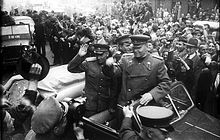
Konew in Prague, May 1945
Historical-scientific reappraisal
The end of the war in the East, which is set with the beginning of the Vistula-Oder operation of the Soviet Army from January 12, 1945, and is considered to be essentially completed with the surrender of the defense of Berlin on May 2, 1945, comes under increasing criticism in the reappraisal that has been carried out to date.
Thus, in the preface to the new edition of Cornelius Ryan's The Last Stand, published unchanged in 2015, historian Johannes Hürter writes: "There is still, however, a lack of satisfactory overall scholarly accounts of the end of the war in the East, the occupation of Berlin, and Berlin society (and city administration) in the final months of the war."
J. Hürter also quotes Michael Wildt/Christoph Kreutzmüller: "In the preface [p. 7] it is stated for the entire Nazi period that it is astonishing how little the history of the city and its society has been reappraised, especially for this period."
Hürter notes corresponding omissions even for the standard work of the Military History Research Office: while it "offers a detailed operational history of the battle for Berlin, it refrains from any closer analysis of the fate of the civilian population in this inferno."
Questions and Answers
Q: What was the Battle of Berlin?
A: The Battle of Berlin was the final major battle of the Second World War in Europe.
Q: When did the Battle of Berlin take place?
A: The Battle of Berlin took place from 16 April to 3 May 1945.
Q: Who captured the city of Berlin during the battle?
A: The Red Army, along with Polish forces, captured the city of Berlin, Germany.
Q: What happened when the Reichstag was captured?
A: When the Reichstag was captured, Adolf Hitler committed suicide by shooting himself in the head and his new wife took a cyanide pill.
Q: Who committed suicide during the Battle of Berlin?
A: Adolf Hitler committed suicide during the Battle of Berlin.
Q: What was the cause of Adolf Hitler's death during the Battle of Berlin?
A: Adolf Hitler shot himself in the head, and his new wife took a cyanide pill.
Q: What was the outcome of the Battle of Berlin?
A: The outcome of the Battle of Berlin was the capture of Berlin by the Red Army and Polish forces.
Search within the encyclopedia